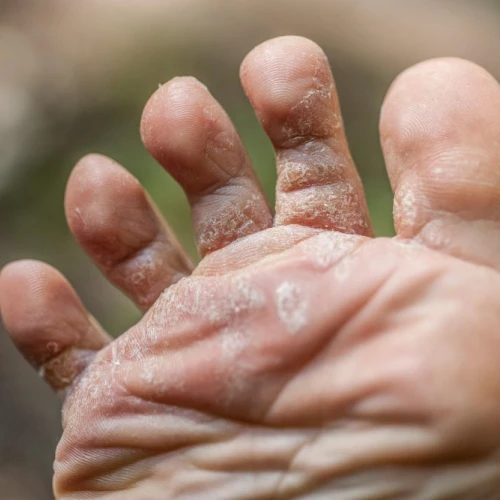What is a fungal foot infection?1, 2
More commonly known as “athlete's foot”, a fungal foot infection is a common problem in adults. It usually affects the skin between the little toes, particularly the skin between the 3rd and 4th toes and the skin between the 4th and 5th toes. The cause is a microscopic fungus caught after entering into contact with an infected surface.
What are the symptoms of a fungal foot infection?1, 2
Skin infected by a fungus turns red, is covered in vesicular blisters and peels off (whitish-coloured dry or oozing desquamation). Maceration then occurs in this area of the skin, which is known as intertrigo. It is very itchy and those affected feel an irrepressible urge to scratch, which can aggravate the situation. The fungus may spread to other spaces between the toes and to the whole foot, with the appearance of red areas on the sole, heel and back of the foot. These reddened areas then become covered with cracks and fluid-filled bullae, which are very itchy. Athlete's foot is often associated with a nail infection, known as onychomycosis.
How do you get a fungal foot infection?1, 2
The fungus most often implicated in athlete's foot is trichophyton rubrum. It belongs to the family of dermatophytes, which are filamentous fungi that grow readily on the skin, hair and nails. Trichophyton rubrum penetrates the skin when it is damp and weakened (wounds, blisters, dry).
Are fungal foot infections contagious?2, 3
A fungal foot infection is highly contagious. It is generally spread indirectly from person to person following the presence of infected skin flakes on the ground in public areas (e.g. sports halls, bathrooms, public swimming pools, etc.). The fungus responsible for the infection enters the skin through any small lesion such as an abrasion or a wound.
What is the quickest way to treat a fungal foot infection?4
You can treat fungal foot infections at home provided that treatment is started early. If the fungal infection is mild and limited in size (i.e. the nails and entire foot are unaffected), you can apply over-the-counter topical antifungal products (cream, gel, spray, powder). Ask your chemist for advice about the best solution for your situation and how long the treatment will last. Before and after each application of the antifungal to infected areas, wash your hands and dry the skin thoroughly.
When do you need to see a doctor?4
You should see a doctor in the following cases:
- If one or more nails are affected;
- If the lesions do not improve after one week of topical treatment;
- If you experience discomfort, local pain or the itchiness is affecting your daily life;
- If further signs of fungal infection appear in other areas;
- If you notice any open lesions (wounds, oozing, etc.) that may become superinfected.
- If your state of health requires special monitoring (diabetes, peripheral arterial disease of the lower limbs, immune deficiency, corticosteroid treatment).
Medical treatment of fungal foot infections5
If over-the-counter topical treatment has not cured the fungal foot infection, your doctor may prescribe antifungal medication. This may be a topical antifungal treatment (ointment, cream, lotion, powder, etc.) stronger than those available without a prescription. Treatment generally lasts for several weeks. You must follow the treatment until it has been completed even if you think that the lesions have disappeared, otherwise the fungus may reappear.
If the athlete's foot has spread to your nails, your doctor will prescribe a topical antifungal treatment in the form of a nail varnish, to be applied for 3 to 6 months. The treatment may be supplemented by topical creams that will chemically destroy the nail.
In some cases (severe infection or several nails affected), topical treatments may not be enough. You will then be prescribed an oral antifungal treatment. This treatment generally lasts for six months.
In the most serious cases, surgery is required to remove the diseased area of the nail.
What are the risk factors?3
The risk factors for fungal foot infections are:
- Wearing narrow shoes, as feet sweat more in such footwear;
- Very sweaty feet;
- Poor foot hygiene;
- Not drying your feet properly after a shower, bath or swim (moisture collects between the toes);
- Sharing infected personal effects (bath towels, socks, pool sliders, etc.);
- Walking barefoot in potentially infected areas.
How do you prevent fungal foot infections?6, 7, 8, 9
The best way to prevent athlete's foot is to limit the amount of moisture on your feet and in your shoes, and avoid coming into direct contact with an infected surface. For this, it is recommended that you:
- Wear open or “breathable” shoes, and change your socks frequently, especially in hot weather.
- Do not wear shoes that are too tight or socks and made out of synthetic material (e.g. nylon) that prevent sweat from escaping.
- Dry the space between the toes thoroughly after a bath, shower or swimming.
- Apply absorbent antifungal powder if you have very sweaty feet.
- Wear sandals in public showers and changing rooms or around swimming pools to avoid coming into direct contact with potentially infected areas.
- Regularly wash socks, stockings, bathroom mats and towels.
- Avoid wearing the same socks two days in a row to allow sweat to escape;
- Disinfect your shoes with the appropriate products (ask your chemist for advice).


